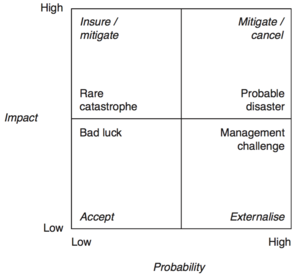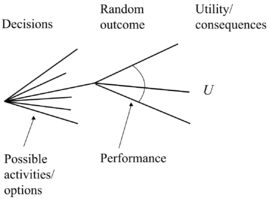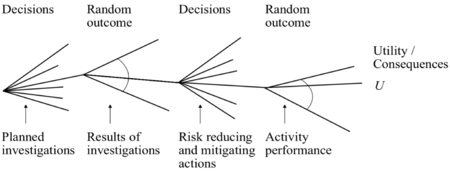Decision tree
(→Initial Steps to Decision making) |
(→Define Consequence and Likelihood Ranges) |
||
| Line 32: | Line 32: | ||
===Define Consequence and Likelihood Ranges=== | ===Define Consequence and Likelihood Ranges=== | ||
| − | [[File:ProbabilityImpact.png|300px|center|thumb|Figure 1. | + | [[File:ProbabilityImpact.png|300px|center|thumb|Figure 1. The probability/impact matrix. <ref name="MCP" />]] |
yes yes yes | yes yes yes | ||
Revision as of 13:12, 20 September 2017
Contents |
Abstract
Decision Tree as a tool in Risk Management.
When the risks have been identified and the respective impacts and probabilities have been investigated, the decision whether to insure, mitigate, accept or externalise the risk in question will result in different possible outcomes with different probabilities and consequences. From these different branches other risk decisions will be made, and in the end a decision tree with all the possible different paths to what risks will be managed and how, will be established.
This wiki article investigates how the decision tree works as a tool in risk management, what the benefits are and what barriers are related to this tool.
1. The Decision Tree Concept
2. Applying the Decision Tree to Project Management
3. Other Risk Management Tools Involved
4. Benefits and Possibilites
5. Limitations and Barriers
6. Conclusion
7. References
8. Annotated Bibliography
Writer: Frederik Lind, s133570
Initial Steps to Decision Making
Risk Identification
Consider Both Threats and Opportunities [1]
Define Consequence and Likelihood Ranges

yes yes yes
yes yes yes
yes yes yes Yes yes yes yes yes yes yes yes yes yes yes yes yes yes yes yes yes yes yes yes yes yes yes yes yes yes yes yes yes yes yes yes yes yes yes yes yes yes yes yes
yes yes yes
yes yes yes
yes yes yes
The Decision Tree Concept


Applying the Decision Tree to Project Management
Other Risk Management Tools Involved
Benefits and Possibilites
Limitations and Barriers
Conclusion
References
- ↑ Geraldi, Joana and Thuesen, Christian and Stingl, Verena and Oehmen, Josef (2017) How to DO Projects? A Nordic Flavour to Managing Projects: DS-handbook, Version 1.0, Publisher: Dansk Standard
- ↑ Winch, Graham M. (2010) Managing Construction Projects - An Information Processing Approach, 2nd Edition, Publisher: John Wiley & Sons, Ltd.
- ↑ 3.0 3.1 Faber, Michael Havbro (2010) Statistics and Probability Theory - In Pursuit of Engineering Decision Support, Publisher: Springer International Publishing AG.